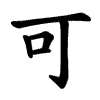可
- to be right, proper, permissible, or possible;
- to approve or allow;
Also used as an auxiliary particle for possibility (“can, may”).
Etymology
Ideogrammatic compound:
Composed of 口 (입 구, “mouth”) and a right-side component resembling 丁 or 丂, originally depicting voice or affirmation.
The ancient form represented the mouth making a sound of assent, hence the sense of “to approve” or “to say yes.”
Although the right element looks similar to 丁, oracle bone forms of 丁 were square, not angular, so the original right-side shape of 可 is closer to 丂, an archaic sign related to breathing or speaking.
Thus, 可 originally expressed verbal assent or approval, which naturally extended to rightness, permission, and possibility.
Usage in Korean
허가 (許可) — permission, approval
인가 (認可) — authorization
가능 (可能) — possibility
가결 (可決) — approval or passing of a proposal
가인 (可人) — agreeable person; charming
In modern Korean, 可 retains dual nuances:
Normative — right, proper (옳다, 가하다).
Modal — possible, permitted (할 수 있다).
It is also seen as a grade marker (수·우·미·양·가), where 가 represents “barely acceptable, sufficient.”
Words that derived from 可
Additional notes
In oracle bone inscriptions (甲骨文), 可 appeared as a simple pictograph of a mouth (口) uttering agreement or approval, marking one of the earliest expressions of verbal affirmation.
In classical Chinese, 可 was both a lexical verb and a modal auxiliary, used for:
Approval / Rightness:
「此可謂善矣。」
“This may be called good” — Mencius (孟子).
Possibility / Permission:
「可乎?」
“Is it permissible?” — Zuo Zhuan (左傳).
Affirmation / Emphasis:
「可也。」 — “Indeed so.”
As Chinese grammar evolved, this modal function was inherited by modern Mandarin 可 (kě) and the fixed collocation 可以 (kěyǐ) meaning “may, can, be allowed to.”
Cultural & linguistic notes:
In Confucian ethics, 可 symbolizes moral assent — what may or should be done.
「可不可之間,君子以禮制之。」
“Between what is permissible and impermissible, the gentleman governs himself by propriety.”
In legal and bureaucratic language, 可 has long signified official approval or sanction, appearing in imperial decrees as “可” (meaning “approved”).
The modal compound 可以 (kěyǐ) emerged as early as the Han dynasty, reflecting the broader philosophical transition from objective approval (rightness) to subjective permission (may / can).
Symbolic interpretation:
可 represents spoken assent, moral propriety, and possibility.
Its simplicity conceals a deep universality — to say “yes,” “right,” or “may” is to bridge human thought and action.
「言可則行可。」
“When speech is proper, conduct follows rightly.”
Thus, 可 signifies not only external permission but inner alignment with what is right — the harmony between truth, choice, and expression.
